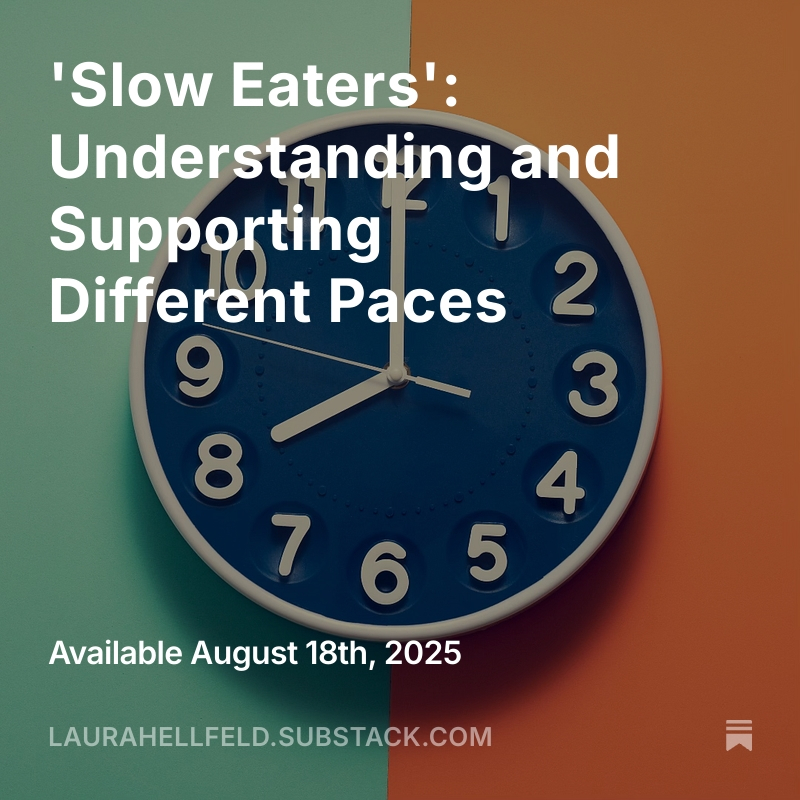A Story: Supporting a Young Person’s Pace of Eating
I met Sarah (named changed for privacy) while running a workshop on supporting your young person with food and eating. Her description of her young person’s eating shows us one of many different reasons behind someone’s ‘slow eating’.
Sarah reported that she was concerned that her 6 year-old was taking nearly 45 minutes to eat their breakfast. This was causing stressful mornings and she was concerned that her young person wasn’t getting enough energy in for the day. We discussed watching their young person during the next few breakfast times and being curious. After some observation, Sarah realised her young person needed quiet to eat. Their auditory sensitivity meant mealtimes in a group and where everyone was getting ready were overwhelming. Sarah began offering ear defenders and supporting their young person to eat in a quieter spot. This helped them to feel calmer and more able to eat.
Eating slowly can sometimes be misunderstood. We live in a culture that often values speed and efficiency, even at mealtimes.
If you or someone you care for is a slow eater, this article is here to help you understand why that might be. And importantly, how you can offer support that respects their unique pace.
Image from Canva, by Tatomm from Getty Images
You might also be interested in my co-authored book about an Autistic young person and their same food ‘Gabby’s Glimmers’ and my other food blogs such as ‘Context Eating: Why We Prefer Specific Foods in Specific Situations‘, ‘Why We Need Low Pressure Food Opportunities‘ and ‘How to Get Them to Eat: Rethinking Some Traditional Parenting Strategies‘
What Does It Mean to Be a Slow Eater?
A slow eater might take a long time to finish meals, eat in small amounts throughout a long period, or seem easily distracted during mealtime. This can be a lifelong trait or something that changes over time due to stress, health, or sensory experiences.
A Neuro-Affirming Perspective
Many neurodivergent individuals experience eating in ways that may differ from typical social expectations. The pace of eating might be influenced by sensory sensitivities (ie. like texture or smell) or differences with interoception (how the body senses hunger and fullness).
For many people, eating is more than fuelling the body. It’s also part of how some people regulate their emotions, process their environment, and create stability. Therefore, pressuring someone to “hurry up” or “clean their plate” can cause anxiety and make mealtimes a source of distress.
When Slow Eating Might Be Connected to Healthcare
While slow eating may be a pacing difference, sometimes it can signal an underlying medical issue. This may be especially true if you notice a new behaviour around food opportunities or if weight and/or nutrition are concerns. It’s worth consulting a healthcare professional if you notice:
- Difficulty chewing or swallowing
- Signs of gastrointestinal discomfort like reflux or constipation
- Significant anxiety or distress around meals
- Fatigue or low energy
- Weight loss or reduced growth
Why Else Do People Eat Slowly?
Some common reasons include:
- Sensory Sensitivities: Strong reactions to textures, flavors, or smells can slow down eating.
- Interoception Differences: Difficulty sensing hunger or fullness can affect the eating pace.
- Motor or Coordination: Physical effort required to eat can take more time.
- Executive Function Demands: Managing the steps of eating, staying in one place and giving attention to eating is harder for some.
- Emotional Factors: Anxiety or feeling rushed can disrupt eating.
How to Support a Slow Eater
Everyone is different but here are a few ideas:
- Give Plenty of Time: Avoid rushing or setting strict time limits at meals. Slow eaters often do best when mealtime isn’t pressured. If someone is attending a school setting, work with staff to ensure your young person is one of the first served their food to give them as much time as possible.
- Create a Calm Environment: Reduce noise and bright lights that might overwhelm sensory processing.
- Support Breaks and Movement: Some people benefit from pausing, stretching, or moving briefly during meals.
- Use Sensory Supports: Find utensils, plates, and seating arrangements (ie. pillows, cushions) that feel comfortable.
- Neutral Talk: Avoid food-related pressure like “Just two more bites” or “Hurry up” or “Just finish”. Instead, your young person may need quiet to eat or offer connection through discussing their interests
- Offer Snacks: If meals take longer or are smaller, snacks can help maintain energy without stress.
- Knowledge that this isn’t a purely behavioural issue & therefore there isn’t a place for consequences
Reflect and Reframe
Next time you’re at a food opportunity with someone eating at a slower pace, consider:
- What expectations do I hold about how quickly people ‘should’ eat?
- Could my expectations be influenced by my own upbringing or social norms?
- How can I support this person’s pace with kindness and curiosity rather than frustration?
Thank you for learning about the community,

Laura Hellfeld
RN, MSN, PHN, CNL
Sign up to my Newsletter Here
Connect with me on social media
BlueSky, LinkedIn, Instagram and Facebook
Disclaimer: The information shared in this blog is for informational purposes only and is not intended to replace medical advice, diagnosis, or treatment. Please consult a licensed healthcare provider for personalised support and care tailored to your specific needs.
Resources & Signposting
- Gabby’s Glimmers: An Affirming Story of an Autistic Child and their Favourite Food
- Context Eating: Why We Prefer Specific Foods in Specific Situations, Blog
- More on Context Eating: Understanding Food Preferences Without Pushing for Change, Blog
- Why We Need Low Pressure Food Opportunities, Blog
- How to Get Them to Eat: Rethinking Some Traditional Parenting Strategies, Blog
Last modified: 22 July 2025


